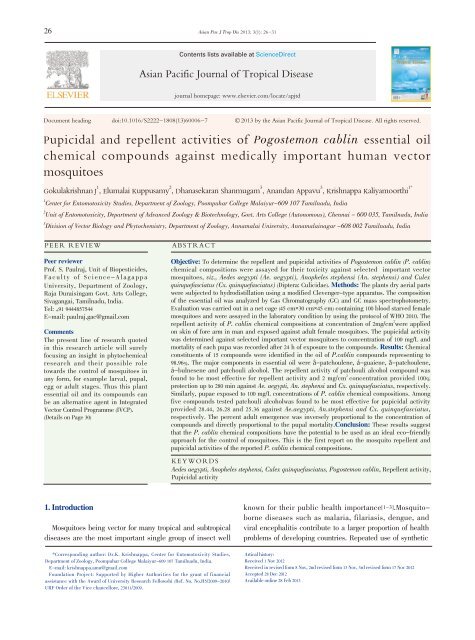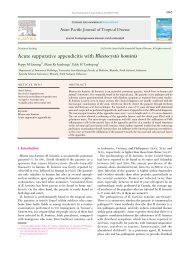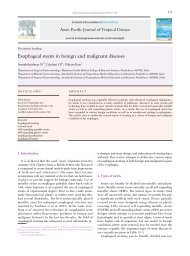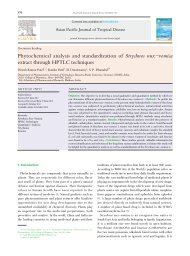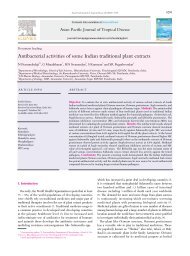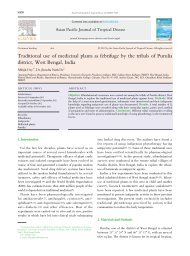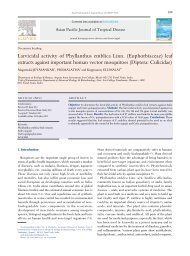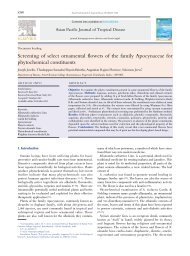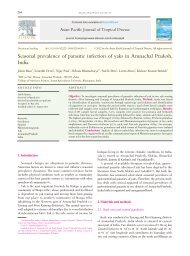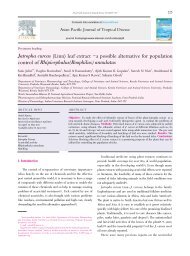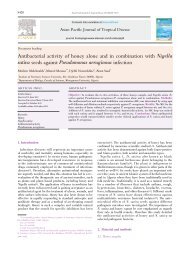Pupicidal and repellent activities of Pogostemon cablin ... - Apjtcm.com
Pupicidal and repellent activities of Pogostemon cablin ... - Apjtcm.com
Pupicidal and repellent activities of Pogostemon cablin ... - Apjtcm.com
Create successful ePaper yourself
Turn your PDF publications into a flip-book with our unique Google optimized e-Paper software.
26<br />
Asian Pac J Trop Dis 2013; 3(1): 26-31<br />
Asian Pacific Journal <strong>of</strong> Tropical Disease<br />
journal homepage: www.elsevier.<strong>com</strong>/locate/apjtd<br />
Document heading doi:10.1016/S2222-1808(13)60006-7 襃 2013 by the Asian Pacific Journal <strong>of</strong> Tropical Disease. All rights reserved.<br />
<strong>Pupicidal</strong> <strong>and</strong> <strong>repellent</strong> <strong>activities</strong> <strong>of</strong> <strong>Pogostemon</strong> <strong>cablin</strong> essential oil<br />
chemical <strong>com</strong>pounds against medically important human vector<br />
mosquitoes<br />
Gokulakrishnan J 1 , Elumalai Kuppusamy 2 , Dhanasekaran Shanmugam 3 , An<strong>and</strong>an Appavu 3 , Krishnappa Kaliyamoorthi 1*<br />
1<br />
Center for Entomotoxicity Studies, Department <strong>of</strong> Zoology, Poompuhar College Malaiyur-609 107 Tamilnadu, India<br />
2<br />
Unit <strong>of</strong> Entomotoxicity, Department <strong>of</strong> Advanced Zoology & Biotechnology, Govt. Arts College (Autonomous), Chennai - 600 035, Tamilnadu, India<br />
3<br />
Division <strong>of</strong> Vector Biology <strong>and</strong> Phytochemistry, Department <strong>of</strong> Zoology, Annamalai University, Annamalainagar -608 002 Tamilnadu, India<br />
PEER REVIEW ABSTRACT<br />
Peer reviewer<br />
Pr<strong>of</strong>. S. Paulraj, Unit <strong>of</strong> Biopesticides,<br />
F a c u l t y o f S c i e n c e – A l a g a p p a<br />
University, Department <strong>of</strong> Zoology,<br />
Raja Duraisingam Govt. Arts College,<br />
Sivagangai, Tamilnadu, India.<br />
Tel: +91 9444857544<br />
E-mail: paulraj.gac@gmail.<strong>com</strong><br />
Comments<br />
The present line <strong>of</strong> research quoted<br />
in this research article will surely<br />
focusing an insight in phytochemical<br />
research <strong>and</strong> their possible role<br />
towards the control <strong>of</strong> mosquitoes in<br />
any form, for example larval, pupal,<br />
egg or adult stages. Thus this plant<br />
essential oil <strong>and</strong> its <strong>com</strong>pounds can<br />
be an alternative agent in Integrated<br />
Vector Control Programme (IVCP).<br />
(Details on Page 30)<br />
1. Introduction<br />
Mosquitoes being vector for many tropical <strong>and</strong> subtropical<br />
diseases are the most important single group <strong>of</strong> insect well<br />
*Corresponding author: Dr.K. Krishnappa, Center for Entomotoxicity Studies,<br />
Department <strong>of</strong> Zoology, Poompuhar College Malaiyur-609 107 Tamilnadu, India.<br />
E-mail: krishnappa.amu@gmail.<strong>com</strong><br />
Foundation Project: Supported by Higher Authorities for the grant <strong>of</strong> financial<br />
assistance with the Award <strong>of</strong> University Research Fellowshi (Ref. No. No.H5/2009-2010/<br />
URF Order <strong>of</strong> the Vice chancellore, 23011/2009.<br />
Contents lists available at ScienceDirect<br />
Objective: To determine the <strong>repellent</strong> <strong>and</strong> pupicidal <strong>activities</strong> <strong>of</strong> <strong>Pogostemon</strong> <strong>cablin</strong> (P. <strong>cablin</strong>)<br />
chemical <strong>com</strong>positions were assayed for their toxicity against selected important vector<br />
mosquitoes, viz., Aedes aegypti (Ae. aegypti), Anopheles stephensi (An. stephensi) <strong>and</strong> Culex<br />
quinquefasciatus (Cx. quinquefasciatus) (Diptera: Culicidae). Methods: The plants dry aerial parts<br />
were subjected to hydrodistillation using a modified Clevenger-type apparatus. The <strong>com</strong>position<br />
<strong>of</strong> the essential oil was analyzed by Gas Chromatography (GC) <strong>and</strong> GC mass spectrophotometry.<br />
Evaluation was carried out in a net cage (45 cm×30 cm×45 cm) containing 100 blood starved female<br />
mosquitoes <strong>and</strong> were assayed in the laboratory condition by using the protocol <strong>of</strong> WHO 2010. The<br />
<strong>repellent</strong> activity <strong>of</strong> P. <strong>cablin</strong> chemical <strong>com</strong>positions at concentration <strong>of</strong> 2mg/cm 2<br />
were applied<br />
on skin <strong>of</strong> fore arm in man <strong>and</strong> exposed against adult female mosquitoes. The pupicidal activity<br />
was determined against selected important vector mosquitoes to concentration <strong>of</strong> 100 mg/L <strong>and</strong><br />
mortality <strong>of</strong> each pupa was recorded after 24 h <strong>of</strong> exposure to the <strong>com</strong>pounds. Results: Chemical<br />
constituents <strong>of</strong> 15 <strong>com</strong>pounds were identified in the oil <strong>of</strong> P.<strong>cablin</strong> <strong>com</strong>pounds representing to<br />
98.96%. The major <strong>com</strong>ponents in essential oil were â-patchoulene, á-guaiene, ã-patchoulene,<br />
á-bulnesene <strong>and</strong> patchouli alcohol. The <strong>repellent</strong> activity <strong>of</strong> patchouli alcohol <strong>com</strong>pound was<br />
found to be most effective for <strong>repellent</strong> activity <strong>and</strong> 2 mg/cm 2 concentration provided 100%<br />
protection up to 280 min against Ae. aegypti, An. stephensi <strong>and</strong> Cx. quinquefasciatus, respectively.<br />
Similarly, pupae exposed to 100 mg/L concentrations <strong>of</strong> P. <strong>cablin</strong> chemical <strong>com</strong>positions. Among<br />
five <strong>com</strong>pounds tested patchouli alcoholwas found to be most effective for pupicidal activity<br />
provided 28.44, 26.28 <strong>and</strong> 25.36 against Ae.aegypti, An.stephensi <strong>and</strong> Cx. quinquefasciatus,<br />
respectively. The percent adult emergence was inversely proportional to the concentration <strong>of</strong><br />
<strong>com</strong>pounds <strong>and</strong> directly proportional to the pupal mortality.Conclusion: These results suggest<br />
that the P. <strong>cablin</strong> chemical <strong>com</strong>positions have the potential to be used as an ideal eco-friendly<br />
approach for the control <strong>of</strong> mosquitoes. This is the first report on the mosquito <strong>repellent</strong> <strong>and</strong><br />
pupicidal <strong>activities</strong> <strong>of</strong> the reported P. <strong>cablin</strong> chemical <strong>com</strong>positions.<br />
KEYWORDS<br />
Aedes aegypti, Anopheles stephensi, Culex quinquefasciatus, <strong>Pogostemon</strong> <strong>cablin</strong>, Repellent activity,<br />
<strong>Pupicidal</strong> activity<br />
known for their public health importance[1-3].Mosquitoborne<br />
diseases such as malaria, filariasis, dengue, <strong>and</strong><br />
viral encephalitis contribute to a larger proportion <strong>of</strong> health<br />
problems <strong>of</strong> developing countries. Repeated use <strong>of</strong> synthetic<br />
Artical history:<br />
Received 1 Nov 2012<br />
Received in revised form 8 Nov, 2nd revised form 13 Nov, 3rd revised form 17 Nov 2012<br />
Accepted 28 Dec 2012<br />
Available online 28 Feb 2013
insecticides for mosquito control has disrupted natural<br />
biological control systems <strong>and</strong> led to resurgences in mosquito<br />
populations. It also resulted in the development <strong>of</strong> resistance,<br />
undesirable effects on non-target organisms, <strong>and</strong> fostered<br />
environmental <strong>and</strong> human health concern[4]. The drastic<br />
effects <strong>of</strong> chemical insecticide-based intervention measures<br />
for the control <strong>of</strong> disease vectors have received wide public<br />
apprehension <strong>and</strong> have caused many problems like insecticide<br />
resistance, resurgence <strong>of</strong> pest species, environmental pollution,<br />
toxic hazards to humans, <strong>and</strong> other nontarget organisms. To<br />
alleviate these problems, major emphasis has been on the use<br />
<strong>of</strong> natural plant-based products as larvicides which can provide<br />
an alternate to synthetic insecticides[5,6].<br />
There is an increased interest in the search for insecticides<br />
from natural sources as they are considered safer, more<br />
cost effective, biodegradable <strong>and</strong> are target specific against<br />
mosquitoes. Several studies have identified <strong>and</strong> reported plants<br />
<strong>and</strong> plant extracts effective against mosquitoes at various<br />
stages <strong>of</strong> development. The phytochemicals derived from plant<br />
sources possess a <strong>com</strong>plex <strong>of</strong> chemicals with unique biological<br />
activity. The phytochemicals derived from plant resources<br />
can act as larvicides, insect growth regulators, <strong>repellent</strong>s, <strong>and</strong><br />
ovipositional attractants, having deterrent <strong>activities</strong> observed<br />
by different researchers[7,8,9,10, 11,12]. The use <strong>of</strong> scientifically<br />
proven non-chemical methods <strong>and</strong> limited use <strong>of</strong> drug is being<br />
considered as safety to environment <strong>and</strong> human health[13,14].<br />
The <strong>Pogostemon</strong> is major genus <strong>of</strong> the family Lamiaceae.<br />
<strong>Pogostemon</strong> has been used against the <strong>com</strong>mon cold <strong>and</strong> as an<br />
antifungal agent in traditional medicine. Lamiaceae herb family<br />
consists <strong>of</strong> more than 252 genus <strong>and</strong> 7 000 Species. Lamiaceae<br />
family is known for the wealth <strong>of</strong> species with medicinal<br />
properties, which have been used since early times <strong>and</strong><br />
many <strong>of</strong> these species are <strong>com</strong>mon in Mediterranean region.<br />
Extensive cultivation <strong>of</strong> this plant is carried out in Malaysia,<br />
Indonesia, India, China, Brazil <strong>and</strong> Pakistan for its essential<br />
oil (patchouli oil). Thus, the constituents <strong>of</strong> patchouli oil have<br />
frequently been investigated, <strong>and</strong> the presence <strong>of</strong> a number <strong>of</strong><br />
mono<strong>and</strong>sesquiterpenoids has been reported[15,16]. The aim <strong>of</strong><br />
the study was to determine the effect <strong>of</strong> <strong>repellent</strong> <strong>and</strong> pupicidal<br />
<strong>activities</strong> <strong>of</strong> the P. <strong>cablin</strong> essential oil <strong>com</strong>pounds against the<br />
selected vector mosquitoes.<br />
2. Materials <strong>and</strong> methods<br />
2.1. Plant material <strong>and</strong> essential oil extraction<br />
The plants fresh aerial parts <strong>of</strong> P. <strong>cablin</strong>, collected from the<br />
forest region <strong>of</strong> Ooty, Uthagam<strong>and</strong>alam District, Tamilnadu,<br />
India. the plant material were collected in the month <strong>of</strong><br />
February 2010, were air dried <strong>and</strong> essential oil was obtained<br />
by hydrodistillation <strong>of</strong> 5kg <strong>of</strong> fresh leaves in a clavenger<br />
apparatus for 4 h. the distilled oil was dried over anhydrous<br />
sodium sulphate <strong>and</strong> stored under nitrogen atmosphere until<br />
further use. The plant material was identified <strong>and</strong> the voucher<br />
Gokulakrishnan J et al./Asian Pac J Trop Dis 2013; 3(1): 26-31 27<br />
specimens were deposited at the department <strong>of</strong> Zoology,<br />
Annamalai University, Annamalai Nagar, Tamilnadu, India.<br />
2.2. Gas Chromatography Analysis<br />
Analysis was carried on a varian-gas chromatograph<br />
equipped with a flame ionization detector <strong>and</strong> a BPI (100%<br />
dimethyl polysiloxane) capillary column. Helium at a flow<br />
rate <strong>of</strong> 1.0 mL/min <strong>and</strong> 8 psi inlet pressure was employed as a<br />
carrier gas. Temperature was programmed from 60 to 220 at 5 °C<br />
min-1with a final hold time <strong>of</strong> 6 min. The injector <strong>and</strong> detector<br />
temperatures were maintained at 250 <strong>and</strong> 300 °C , respectively.<br />
The sample (0.2 µL) was injected with 1:20 split ratio.<br />
2.3. Gas Chromatography - Mass Spectrometry Analysis<br />
Gas chromatography - mass spectrometry (GC-MS) analysis<br />
was performed on an Agilent 6890 GC equipped with 5973 N mass<br />
selective detector <strong>and</strong> an HP-5 (5% phynylmethylpolysiloxane)<br />
capillary column. The oven temperature was programmed from<br />
50 to 280 °C at the rate <strong>of</strong> 4 /min <strong>and</strong> held at this temperature<br />
for 5 min. The inlet <strong>and</strong> interface temperatures were 250 <strong>and</strong><br />
280 °C, respectively. The carrier gas was helium at a flow rate<br />
<strong>of</strong> 1.0 mL/min (constant flow). The sample (0.2µL) was injected<br />
with a split <strong>of</strong> 20:1. Electron impact mass spectrometry was<br />
carried at 70 eV. Ion source <strong>and</strong> quadrupole temperatures were<br />
maintained at 230 <strong>and</strong> 150 °C respectively.<br />
2.4. Mosquito rearing<br />
The mosquitoes, Ae. aegypti, An. stephensi <strong>and</strong> Cx.<br />
quinquefasciatus, were reared in the Department <strong>of</strong> Zoology,<br />
Annamalai University. The larvae were fed on dog biscuits<br />
<strong>and</strong> yeast powder in the 3:1 ratio. Adults were provided with<br />
10% sucrose solution <strong>and</strong> one week old chick for blood meal.<br />
Mosquitoes were held at (28依2) °C, 70%-85% relative humidity<br />
(RH), with a photo period <strong>of</strong> 14 h light, 10 h dark.<br />
2.5. Repellent activity<br />
The <strong>repellent</strong> study was following the methods <strong>of</strong> WHO[17].<br />
3-4 days old blood-starved female <strong>of</strong> selected mosquitoes (100)<br />
were kept in a net cage (45 cm×45 cm×40cm). The volunteer<br />
had no contact with lotions, perfumes or perfumed soaps on<br />
the day <strong>of</strong> the assay. The arms <strong>of</strong> the test person were cleaned<br />
with isopropanol. After air drying the arm only 25 cm 2<br />
<strong>of</strong> the<br />
dorsal side <strong>of</strong> the skin on each arm was exposed, the remaining<br />
area being covered by rubber gloves. The P. <strong>cablin</strong> major<br />
chemical <strong>com</strong>positions were dissolved in 1 mL DMSO <strong>and</strong> this<br />
DMSO served as control. The selected essential oil chemical<br />
<strong>com</strong>positions at 2 mg/cm 2<br />
concentration were applied. The<br />
control <strong>and</strong> treated arms were introduced simultaneously<br />
into the cage. The numbers <strong>of</strong> bites were counted over 5 min<br />
every 30 min. The experiment was conducted five times. It was<br />
observed that there was no skin irritation from the chemical
28<br />
<strong>com</strong>positions. The percentage protection was calculated by<br />
using the following formula.<br />
% Repellency=[(Ta - Tb)/Ta]×100<br />
Where Ta is the number <strong>of</strong> mosquitoes in the control group<br />
<strong>and</strong> Tb is the number <strong>of</strong> mosquitoes in the treated group.<br />
2.6. <strong>Pupicidal</strong> activity<br />
Batches <strong>of</strong> ten early emerged pupae were introduced into<br />
500 mL <strong>of</strong> the test medium containing 100mg/L concentration<br />
<strong>of</strong> essential oil chemical <strong>com</strong>positions in a plastic cups in<br />
five replications. In control, the same number <strong>of</strong> pupae was<br />
maintained in 500 mL <strong>of</strong> dechlorinated water containing<br />
appropriate volume <strong>of</strong> DMSO. All containers were maintained at<br />
room temperature with naturally prevailing photoperiod (12: 12h<br />
/ L: D) in the laboratory. Any pupa was considered to be dead<br />
if did not move when prodded repeatedly with a s<strong>of</strong>t brush.<br />
Mortality <strong>of</strong> each pupa was recorded after 24 h <strong>of</strong> exposure to<br />
the selected concentration <strong>of</strong> chemical <strong>com</strong>positions following<br />
the Abbott formula Abbott[18].<br />
2.7. Statistical Analysis<br />
The data were calculated by using the s<strong>of</strong>tware statistical<br />
package <strong>of</strong> social science (SPSS) version 13.0 for windows,<br />
significance level was set at P
in Tables 2. Among five <strong>com</strong>pounds tested, the maximum<br />
<strong>repellent</strong> activity was observed in patchouli alcohol at 2mg/<br />
cm2concentration provided 100% protection up to 280min against<br />
Ae. aegypti, An. stephensi <strong>and</strong> Cx. quinquefasciatus,respectively.<br />
3.3. <strong>Pupicidal</strong> activity <strong>of</strong> chemical <strong>com</strong>pounds<br />
The pupicidal activity <strong>of</strong> Ae. aegypti, An. stephensi <strong>and</strong> Cx.<br />
quinquefasciatus, were tested with five different <strong>com</strong>pounds<br />
<strong>of</strong> P. <strong>cablin</strong> at 100 mg/L concentration, <strong>and</strong> the results are<br />
listed in Table 3. The percent adult emergence was inversely<br />
proportional to the concentration <strong>of</strong> <strong>com</strong>pounds <strong>and</strong> directly<br />
proportional to the pupal mortality. Among the five different<br />
<strong>com</strong>pounds tested for pupicidal activity against selected vector<br />
mosquitoes, the patchouli alcohol was found to be most effective<br />
for pupicidal activity provided 28.44, 26.28 <strong>and</strong> 25.36 against Ae.<br />
aegypti, An. stephensi <strong>and</strong> Cx. quinquefasciatus, respectively.<br />
4. Discussion<br />
In our results showed that, chemical constituents <strong>of</strong> the<br />
essential oil <strong>of</strong> P. <strong>cablin</strong> have significant repellant <strong>and</strong><br />
pupicidal activity against Ae. aegypti, An. stephensi <strong>and</strong> Cx.<br />
quinquefasciatus mosquito. The results are <strong>com</strong>parable with<br />
an earlier report by Eliningaya et al reported that mortality<br />
<strong>of</strong> Cx. quinquefasciatus ranged from 0.50% to 96.75% while for<br />
An. gambiaes. It was from 13.75% to 97.91% [19]. In the semi-<br />
field experiments, the mortality rates observed varied for<br />
both species with time <strong>and</strong> concentrations. The LC 50 <strong>and</strong> LC95<br />
value in the laboratory was similar for both species while in<br />
the semi- field they were different for each. In wild, adult<br />
mosquitoes, the KT 50 for S. terebinthifolia was 11.29 min while<br />
Gokulakrishnan J et al./Asian Pac J Trop Dis 2013; 3(1): 26-31 29<br />
Table 3<br />
<strong>Pupicidal</strong> activity <strong>of</strong> <strong>Pogostemon</strong> <strong>cablin</strong> essential oil <strong>com</strong>pounds tested against selected vector mosquitoes.<br />
Compounds Mosquitoes Concentration 100mg/L, 24 h <strong>of</strong> exposure period<br />
Mortality* Adult emergence<br />
Pupal mortality % Mortality Adult % Emergence<br />
γ-patchoulene Ae. aegypti 24.25依1.52 i<br />
80.83 5.75依1.86 i<br />
19.16<br />
An. stephensi 22.46依1.46 f<br />
74.86 7.54依1.64 l<br />
25.13<br />
Cx.quinquefasciatus 21.22依1.82 c<br />
70.73 8.78依1.22 o<br />
29.26<br />
patchouli alcohol Ae. aegypti 28.44依1.35 p<br />
94.80 1.56依1.48 b<br />
5.20<br />
An. stephensi 26.28依1.33 m<br />
87.60 3.72依1.62 e<br />
12.40<br />
Cx.quinquefasciatus 25.36依1.42 l<br />
84.53 4.64依1.66 f<br />
15.46<br />
α-bulnesene Ae. aegypti 27.25依1.83 o<br />
90.83 2.57依1.32 c<br />
9.16<br />
An. stephensi 24.64依1.44 j<br />
82.13 5.36依1.52 h<br />
17.86<br />
Cx.quinquefasciatus 23.86依1.65 h<br />
79.53 6.14依1.64 j<br />
20.46<br />
β-patchoulene Ae. aegypti 25.18依1.22 k<br />
83.93 4.82依1.66 g<br />
16.06<br />
An. stephensi 21.83依1.37 e<br />
72.76 8.17依1.72 m<br />
27.23<br />
Cx.quinquefasciatus 20.24依1.62 b<br />
67.46 9.76依1.45 p<br />
32.53<br />
α-guaiene Ae. aegypti 26.38依1.24 n<br />
87.93 3.62依1.36 d<br />
12.06<br />
An. stephensi 23.22依1.83 g<br />
77.40 6.78依1.84 k<br />
22.60<br />
Cx.quinquefasciatus 21.64依1.75 d<br />
72.13 8.36依1.63 n<br />
27.86<br />
Control group Selected mosquitoes 0.0依0.0 a<br />
0.0 0.0依0.0a 0.0<br />
Value represents mean依SD <strong>of</strong> five replications. *Mortality <strong>of</strong> the pupae observed after 24 h <strong>of</strong> exposure period. Values in the column with a<br />
different superscript alphabet are significantly different at P
30<br />
methanol extract <strong>of</strong> Ocimum canum, <strong>and</strong> ethyl acetate extracts<br />
<strong>of</strong> Ocimum sanctum <strong>and</strong> Rhinacanthus nasutus against the<br />
larvae <strong>of</strong> Cx. tritaeniorhynchus (LC50 38.15, 72.40, 109.12,<br />
<strong>and</strong> 39.32 mg/L; LC90 184.67, 268.93, 646.62, <strong>and</strong> 176.39 mg/L),<br />
respectively. The efficacy shown by Schinustere binthifolia<br />
for knock down time <strong>and</strong> 100% mortality after 24 hours to<br />
adult mosquitoes from wild resistant population warrants<br />
further investigation <strong>of</strong> these <strong>com</strong>pounds for IRS small<br />
scale whether singly or in blends. This essential oil may be<br />
<strong>of</strong> great value in <strong>com</strong>plementing other <strong>com</strong>pounds which<br />
are losing efficacy[25]. Kamaraj et al[26] reported that the<br />
highest larval mortality was found in leaf petroleum ether,<br />
flower methanol extracts <strong>of</strong> Cryptocoryne auriculata, flower<br />
methanol extracts <strong>of</strong> Leucas aspera <strong>and</strong> Rhinacanthus<br />
nasutus, leaf <strong>and</strong> seed methanol extracts <strong>of</strong> Solanum torvum,<br />
<strong>and</strong> leaf hexane extract <strong>of</strong> Vitex negundo against the larvae<br />
<strong>of</strong> An. subpictus (LC50 44.21, 44.69, 53.16, 41.07, 35.32, 28.90,<br />
<strong>and</strong> 44.40 mg/L; LC90 187.31, 188.29, 233.18, 142.66, 151.60,<br />
121.05, <strong>and</strong> 192.11 mg/L, respectively) <strong>and</strong> against the larvae<br />
<strong>of</strong> Cx. tritaeniorhynchus (LC50 69.83, 51.29, 81.24, 71.79, 44.42,<br />
84.47, <strong>and</strong> 65.35 mg/L; LC90 335.26, 245.63, 300.45, 361.83, 185.09,<br />
351.41, <strong>and</strong> 302.42 mg/L, respectively).The highest repellency<br />
was observed in Zingiber <strong>of</strong>ficinale, a higher concentration<br />
<strong>of</strong> 5.0 mg/cm 2<br />
provided 100% protection up to 150 <strong>and</strong> 180<br />
min against Cx. tritaeniorhynchus <strong>and</strong> An. subpictus,<br />
respectively[27]. W<strong>and</strong>scheer et al[28] reported the naturally<br />
occurring insecticides may play a more prominent role in<br />
mosquito control programs in the future. Earlier, Georges<br />
et al[29] reported that the n-hexane, ethyl acetate, <strong>and</strong><br />
methanol extracts <strong>of</strong> Cassia nigricans showed 100% larval<br />
mortality against Ochlerotatus triseriatus. This is because<br />
larval habitat treatment is more localized in time <strong>and</strong><br />
space resulting in effective control. In tropical countries,<br />
plants are known to possess larvicidal, ovicidal <strong>and</strong><br />
adulticidal <strong>activities</strong>[30]. Since there is no previous record<br />
<strong>of</strong> literature available about the mosquitocidal activity <strong>of</strong><br />
the selected chemical <strong>com</strong>pounds <strong>of</strong> P. <strong>cablin</strong> these present<br />
investigations serve as first h<strong>and</strong> information. The finding<br />
<strong>of</strong> the present investigation revealed that the chemical<br />
<strong>com</strong>pounds <strong>of</strong> P. <strong>cablin</strong> possessed remarkable <strong>repellent</strong> <strong>and</strong><br />
pupicidal activity against selected vector mosquitoes.<br />
Conflict <strong>of</strong> interest statement<br />
We declare that we have no conflict <strong>of</strong> interest.<br />
Acknowledgements<br />
The authors are thankful to Higher Authorities for the<br />
grant <strong>of</strong> financial assistance with the Award <strong>of</strong> University<br />
Research Fellowship (Ref. No. No.H5/2009-2010/ URF Order<br />
<strong>of</strong> the Vice chancellore, 23011/2009) <strong>and</strong> also Pr<strong>of</strong>essor <strong>and</strong><br />
Head, Department <strong>of</strong> Zoology, Annamalai University for the<br />
laboratoryfacilities provided.<br />
Gokulakrishnan J et al./Asian Pac J Trop Dis 2013; 3(1): 26-31<br />
Comments<br />
Background<br />
Mosquitoes are well known for their public health<br />
importance since they cause major health problems <strong>and</strong><br />
diseases. Indiscriminate use <strong>of</strong> several mosquitocidal agents<br />
caused various side effects. Thus there is a need to develop<br />
an alternative strategies to control vector mosquitoes. One<br />
such strategy is utilizing the plant <strong>and</strong> their secondary<br />
metabolites. In india, nearly 8000 plant species have been<br />
reported so far towards their insecticidal properties. In<br />
these, context, the present study was aimed to investigate<br />
the mosquitocidal activity <strong>of</strong> <strong>Pogostemon</strong> <strong>cablin</strong> essential<br />
oil against Aedes aegypti, Anopheles stephensi <strong>and</strong> Culex<br />
quinquefasciatus mosquitoes.<br />
Research frontiers<br />
The data obtained from the present experiments are in<br />
close agreement with the earlier reports <strong>of</strong> Saravanan et al<br />
(2007), Bagavan et al (2008) <strong>and</strong> Eliningala et al., (2011).<br />
Related reports<br />
In this present investigation, they have followed<br />
st<strong>and</strong>ard protocols to assess the mosquitocidal actions <strong>of</strong><br />
selected plant essential oil. Their results showed that, The<br />
percent adult emergence was inversely proportional to the<br />
concentration <strong>of</strong> <strong>com</strong>pounds <strong>and</strong> directly proportional to the<br />
pupal mortality. Among the five different <strong>com</strong>pounds tested<br />
for pupicidal activity against selected vector mosquitoes,<br />
the patchouli alcohol was found to be most effective for<br />
pupicidal activity provided 28.44, 26.28 <strong>and</strong> 25.36 against Ae.<br />
aegypti, An. stephensi <strong>and</strong> Cx. quinquefasciatus, respectively.<br />
These findings are in close with the earlier findings <strong>of</strong><br />
Saravanan et al (2007), Bagavan et al (2008) <strong>and</strong> Eliningala et<br />
al., (2011).<br />
Innovations & breakthroughs<br />
Since, there is no previous record <strong>of</strong> literature available<br />
about the mosquitocidal activity <strong>of</strong> the selected plant<br />
essential oil <strong>and</strong> its <strong>com</strong>ponents, the present report serve<br />
as first h<strong>and</strong> information on <strong>repellent</strong> <strong>and</strong> pupicidal<br />
<strong>activities</strong> against the adult <strong>and</strong> pupae <strong>of</strong> the selected vector<br />
mosquitoes.<br />
Applications<br />
Plants are always considered as vast repository <strong>of</strong> natural<br />
<strong>com</strong>pounds, the exploration <strong>of</strong> research leading to their<br />
possible utilization certainly pave the way for search <strong>of</strong><br />
new phytochemical <strong>com</strong>pounds <strong>and</strong> their proper role in the<br />
near future as eco-friendly natural pesticides. These plant<br />
secondary metabolites can be used in nature as they are<br />
easily biodegradable, <strong>and</strong> safer to human beings.<br />
Peer review<br />
The present line <strong>of</strong> research quoted in this research article
will surely focusing an insight in phytochemical research<br />
<strong>and</strong> their possible role towards the control <strong>of</strong> mosquitoes<br />
in any form, for example larval, pupal, egg or adult stages.<br />
Thus this plant essential oil <strong>and</strong> its <strong>com</strong>pounds can be an<br />
alternative agent in Integrated Vector Control Programme<br />
(IVCP).<br />
References<br />
[1] World Health Organisation, Malaria. http://www.who.int/<br />
mediacentre/factsheets/fs094/en/ WHO, Geneva, 2010.<br />
[2] Kamaraj C, Bagavan A, Rahuman AA, Zahir AA, Elango G,<br />
P<strong>and</strong>iyan G. Larvicidal potential <strong>of</strong> medicinal plant extracts<br />
against Anopheles subpictus Grassi<strong>and</strong> Culex tritaeniorhynchus<br />
Giles (Diptera: Culicidae). Parasitol Res 2009; 104(5): 163-1171.<br />
[3] Klempner MS, Unnash TR, Hu LT. Taking a bite out <strong>of</strong> vectortrantmitted<br />
infectious diseases. N Engl J Med 2007; 356: 2567-<br />
2569.<br />
[4] Thomas TG, Rao S, Lal S. Mosquito larvicidal properties <strong>of</strong> an<br />
indigenous plant, Ipomoea cairica, Linn. Jpn J Infect Dis 2004; 57:<br />
176-177.<br />
[5] Govindarajan M, Mathivanan T, Elumalai K, Krishnappa K,<br />
An<strong>and</strong>an A. Ovicidal <strong>and</strong> <strong>repellent</strong> <strong>activities</strong> <strong>of</strong> botanical extracts<br />
against Culex quinquefasciatus, Aedes aegypti <strong>and</strong> Anopheles<br />
stephensi (Diptera: Culicidae). Asian Pac J Trop Biomed 2011a; 1:<br />
43-48.<br />
[6] Govindarajan M, Mathivanan T, Elumalai K, Krishnappa<br />
K,An<strong>and</strong>an A. Mosquito larvicidal, ovicidal, <strong>and</strong> <strong>repellent</strong><br />
properties <strong>of</strong> botanical extracts against Anopheles stephensi,<br />
Aedes aegypti, <strong>and</strong> Culex quinquefasciatus (Diptera: Culicidae).<br />
Parasitol Res 2011b; 109(2): 353-367.<br />
[7] Mathew N, Anitha MG, Bala TSL, Sivakumar SM, Narmadha<br />
R, Kalyanasundaram M. Larvicidal activity <strong>of</strong> Saraca indica,<br />
Nyctanthes arbor-tristis<strong>and</strong> Clitoria ternatea extracts against<br />
three mosquito vector species. Parasitol Res 2009; 104(5): 1017-<br />
1025.<br />
[8] Rawani A, Ghosh A, Ch<strong>and</strong>ra G. Mosquito larvicidal <strong>activities</strong> <strong>of</strong><br />
Solanum nigrum L. leaf extract against Culex quinquefasciatus<br />
Say. Parasitol Res 2010; 107(5): 1235-1240.<br />
[9] Pavela R, Vrchotova N, Triska J. Mosquitocidal <strong>activities</strong> <strong>of</strong> thyme<br />
oils (Thymus vulgaris L.) against Culex quinquefasciatus (Diptera:<br />
Culicidae). Parasitol Res 2009; 105(5): 1365-1370.<br />
[10] Koliopoulos G, Pitarokili D, Kioulos E, Michaelakis A, Tzakou O.<br />
Chemical <strong>com</strong>position <strong>and</strong> larvicidal evaluation <strong>of</strong> Mentha, Salvia,<br />
<strong>and</strong> Melissa essential oils against the West Nile virus mosquito<br />
Culex pipiens. Parasitol Res 2010; 107(2): 327-335.<br />
[11] Evergetis E, Michaelakis A, Kioulos E, Koliopoulos G,<br />
Haroutounian SA. Chemical <strong>com</strong>position <strong>and</strong> larvicidal activity <strong>of</strong><br />
essential oils from six Apiaceae family taxa against the West Nile<br />
virus vector Culex pipiens. Parasitol Res 2009; 105(1):117-124.<br />
[12] Matasyoh JC, Dittrich B, Schueffler A,Laatsch H. Larvicidal<br />
activity <strong>of</strong> metabolites from the endophytic Podospora sp. against<br />
the malaria vector Anopheles gambiae. Parasitol Res 2011; 108(3):<br />
561-566.<br />
[13] Isman MB. Botanical insecticides, deterrents <strong>and</strong> <strong>repellent</strong>s in<br />
modern agriculture <strong>and</strong> an increasingly regulated world. Ann Rev<br />
Entomol 2006; 3: 51- 45.<br />
[14] Worku M, Franco RA, Miller JE. Evaluation <strong>of</strong> the activity <strong>of</strong> plant<br />
extracts in Boer goats. Am J Anim Vet Sci 2009; 4: 4-72.<br />
[15] Wu J, Lu X, Tang W, Kong H, Zhou S, Xu G. Application <strong>of</strong><br />
Gokulakrishnan J et al./Asian Pac J Trop Dis 2013; 3(1): 26-31 31<br />
<strong>com</strong>prehensive two dimensional gas chromatography-time<strong>of</strong>-flight<br />
mass spectrometry in the analysis <strong>of</strong> volatile oil <strong>of</strong><br />
traditional Chinese medicines. J Chromato A 2004; 1034: 199-205.<br />
[16] Deguerry F, Pastore L, Wu S, Clark A, Chappell J, Schalk M. The<br />
diverse sesquiterpene pr<strong>of</strong>ile <strong>of</strong> patchouli, <strong>Pogostemon</strong> <strong>cablin</strong>, is<br />
correlated with limited number <strong>of</strong> sesquiterpene synthases. Arch<br />
Biochm Bioph 2006; 454: 123-126.<br />
[17] WHO. Report <strong>of</strong> the WHO informal consultation on the evaluation<br />
<strong>and</strong> testing <strong>of</strong> insecticides CTD/WHO PES/IC/96.1. Geneva: WHO;<br />
1996, p. 69.<br />
[18] Abbott WS. A method <strong>of</strong> <strong>com</strong>puting the effectiveness <strong>of</strong> an<br />
insecticide. J Econ Entomol 1925; 18: 265-267.<br />
[19] Eliningaya J, Kweka L, MrambaNyindo, Franklin Mosha, Ary<br />
G, Silva. Insecticidal activity <strong>of</strong> the essential oil from fruits <strong>and</strong><br />
seeds <strong>of</strong> Schinustere binthifolia Raddi against African malaria<br />
vectors. Parasites <strong>and</strong> Vectors 2011; 4: 129.<br />
[20] Saravanan KS, Periyanayagam K, Ismail M. Mosquito larvicidal<br />
properties <strong>of</strong> various extract <strong>of</strong> leaves <strong>and</strong> fixed oil from the seeds<br />
<strong>of</strong> Caesalpinia bonduc (L) Roxb. J Commun Dis 2007; 39(3): 153-<br />
157.<br />
[21] Mathivanan T, Govindarajana M, Elumalai K, Krishnappa K,<br />
Ananthan A. Mosquito larvicidal <strong>and</strong> phytochemical properties <strong>of</strong><br />
Ervatamia coronaria Stapf. (Family: Apocynaceae). J Vector Borne<br />
Dis 2010; 47: 178-180.<br />
[22] Mohan L, Sharma P, Srivastava CN. Comparative efficacy <strong>of</strong><br />
Solanum xanthocarpum extracts alone <strong>and</strong> in <strong>com</strong>bination with<br />
a synthetic pyrethroid, cypermethrin, against malaria vector,<br />
Anopheles stephensi. South Asian J Trop Med Pub Health 2007;<br />
38(2): 256-260.<br />
[23] Govindarajan M, Karuppannan P. Mosquito larvicidal <strong>and</strong><br />
ovicidal properties <strong>of</strong> Eclipta alba (L.) Hassk (Asteraceae) against<br />
chikungunya vector, Aedes aegypti (Linn.) (Diptera: Culicidae).<br />
Asian PacJ Trop Med 2011; 24-28.<br />
[24] Bagavan A, Kamaraj C, Abdul Rahuman A, Elango G, Abduz<br />
Zahir A, P<strong>and</strong>iyan G. Evaluation <strong>of</strong> larvicidal <strong>and</strong> nymphicidal<br />
potential <strong>of</strong> plant extracts against Anopheles subpictus Grassi,<br />
Culex tritaeniorhynchus Giles <strong>and</strong> Aphis gossypii Glover. Parasitol<br />
Res 2008; 104(5): 1109-1117.<br />
[25] Tren R, Roberts D. DDT <strong>and</strong> malaria prevention. Environ Health<br />
Perspect 2010; 118: 14-15.<br />
[26] Kamaraj C, Bagavan A, Rahuman AA, Zahir AA, Elango G,<br />
P<strong>and</strong>iyan G. Larvicidal potential <strong>of</strong> medicinal plant extracts<br />
against Anopheles subpictus Grassi <strong>and</strong> Culex tritaeniorhynchus<br />
Giles (Diptera: Culicidae). Parasitol Res 2008; 104(5): 1163-1171.<br />
[27] Govindarajan M. Larvicidal <strong>and</strong> <strong>repellent</strong> properties <strong>of</strong> some<br />
essential oils against Culex tritaeniorhynchus Giles <strong>and</strong> Anopheles<br />
subpictus Grassi (Diptera: Culicidae). Asian Pac J Trop Med 2011;<br />
4(2): 106-111.<br />
[28] W<strong>and</strong>scheer CB, Duque JE, da Silva MAN, Fukuyama Y, Wohlke<br />
JL, Adelmann J, Fontana JD. Larvicidal action <strong>of</strong> ethanolic<br />
extracts from fruit endocarps <strong>of</strong> Melia azedarach <strong>and</strong> Azadirachta<br />
indica against the dengue mosquito Aedes aegypti. Toxicon 2004;<br />
44: 829-835.<br />
[29] Georges K, Jayaprakasam B, Dalavoy SS, Nair MG. Pest managing<br />
<strong>activities</strong> <strong>of</strong> plant extracts <strong>and</strong> anthraquinones from Cassia<br />
nigricans from Burkina Faso. Bioresour Technol 2008; 99(6): 2037-<br />
2045.<br />
[30] Trudel RE, Bomblies A. Larvicidal effects <strong>of</strong> Chinaberry (Melia<br />
azederach) powder on Anopheles arabiensis in Ethiopia. Parasit<br />
Vectors 2011; 4: 72.


